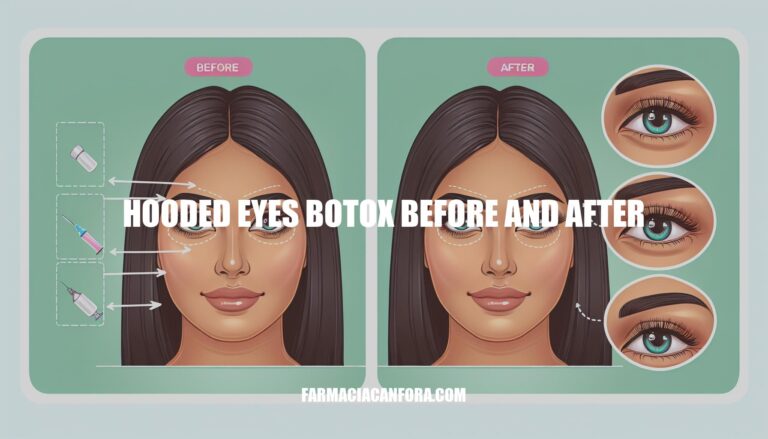Hooded eyes occur when excess skin folds down from the brow bone to the lash line, often giving the eyes a droopy appearance. Many people consider Botox as a treatment option because it can lift and open up the eyes by relaxing the muscles around them. Understanding the before and after effects of Botox on hooded eyes is crucial to set realistic expectations and ensure the desired outcome.
Understanding Hooded Eyes
Hooded eyes are characterized by excess skin folding down from the brow bone, often reaching the lash line. This can create a “hooded” appearance over the eyelid.
Common causes:
- Genetics: Many people are born with hooded eyes as a hereditary trait.
- Aging: As skin loses elasticity with age, it can sag and create hooded eyes.
Effects on appearance and vision:
- Appearance: Hooded eyes can make the eyes look smaller and give a droopy or tired look.
- Vision: In some cases, the excess skin can obscure vision, particularly in the upper and outer parts of the visual field.
How Botox Works for Hooded Eyes
Botox treats hooded eyes by targeting specific muscles around the eyebrows. Here’s how it works:
- Muscle Relaxation: Botox is injected into the muscles that pull the eyebrows down, such as the orbicularis oculi and the corrugator muscles.
- Blocking Nerve Signals: The botulinum toxin in Botox blocks nerve signals to these muscles, reducing their activity.
- Lifting Effect: With the downward-pulling muscles relaxed, the frontalis muscle (which lifts the eyebrows) becomes more dominant, causing a subtle lift of the eyebrows and upper eyelids.
- Open Appearance: This lifting effect reduces the hooded appearance, making the eyes look more open and youthful.
This mechanism provides a non-surgical option for those looking to improve the appearance of hooded eyes.
Before the Botox Treatment
Here’s what patients should expect before undergoing Botox treatment for hooded eyes:
Consultation
- Discussion of Goals: Patients discuss their aesthetic goals and concerns with the provider.
- Medical History: The provider reviews the patient’s medical history, including any allergies and medications.
- Assessment: Examination of the degree of hooding and underlying anatomical factors.
Preparation
- Avoid Blood Thinners: Patients should avoid blood-thinning medications and supplements for a few days before the procedure.
- Disclose Allergies: Inform the provider of any allergies or medications being taken.
- Avoid Alcohol and Strenuous Exercise: On the day of the procedure, patients should avoid alcohol and strenuous activities.
Pre-Treatment Guidelines
- No Smoking: Avoid smoking as it can delay healing.
- Stay Hydrated: Drink plenty of water to stay hydrated.
- Follow Provider’s Instructions: Adhere to any specific instructions given by the provider to ensure optimal results.
After the Botox Treatment
Immediate Effects:
- Appearance: Botox relaxes the muscles around the eyebrows, causing a subtle lift that opens up the eye area, making hooded eyes appear less droopy and more refreshed.
- Recovery Time: Minimal downtime; most people resume normal activities immediately. Some may experience slight redness or swelling at the injection sites.
Long-Term Effects:
- Appearance: The effects typically last 3-4 months. Regular treatments can maintain the lifted appearance, but over time, the muscles may weaken, potentially leading to longer-lasting results.
- Potential Side Effects: Common side effects include bruising, headaches, and temporary drooping of the eyelid if the Botox spreads to unintended areas. Rarely, more serious side effects like vision problems or allergic reactions can occur.
Changes in Appearance:
- Post-Treatment: Hooded eyes appear more open and youthful. The brow lift effect can make the eyes look brighter and more alert.
Real-Life Before and After Examples
Here are some examples of before and after results from Botox treatments for hooded eyes, along with case studies and testimonials:
-
Case Study 1:
- Before: A 45-year-old woman with moderate hooding of the upper eyelids, causing a tired appearance.
- After: Post-treatment, her eyelids appear lifted, and her eyes look more open and youthful. She reported feeling more confident and satisfied with her appearance.
-
Case Study 2:
- Before: A 50-year-old man with significant hooding affecting his vision.
- After: After Botox injections, the hooding was reduced, improving his field of vision and giving a more alert look. He mentioned a noticeable improvement in his daily activities.
-
Testimonial:
- Before: A patient with mild hooding and fine lines around the eyes.
- After: The patient shared that the Botox treatment smoothed out the fine lines and lifted the eyelids slightly, enhancing her overall facial aesthetics. She was pleased with the subtle yet effective results.
These examples highlight the potential benefits of Botox for treating hooded eyes, showcasing both aesthetic and functional improvements.
Hooded Eyes: A Treatable Condition with Botox
Hooded eyes can be treated with Botox, which relaxes muscles around the eyebrows, causing a subtle lift that opens up the eye area and reduces the droopy appearance.
Before undergoing treatment, patients should consult with a qualified professional to discuss their goals, medical history, and undergo an assessment. Preparation includes avoiding blood thinners, disclosing allergies, and adhering to pre-treatment guidelines.
The immediate effects of Botox on hooded eyes include a subtle lift and minimal downtime, while long-term effects typically last 3-4 months with potential side effects including bruising and temporary drooping of the eyelid.
Regular treatments can maintain the lifted appearance, but over time, the muscles may weaken, potentially leading to longer-lasting results. Botox is a non-surgical option for those looking to improve the appearance of hooded eyes, providing a more open and youthful look.


